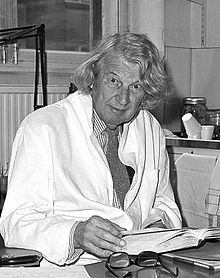John Zachary Young
 John Zachary Young in 1978 | |
| Born | 18 March 1907 |
| Died | 4 July 1997 (Age 90) |
| Nationality | British |
| Alma mater | Magdalen College, University of Oxford |
| Known for | Research on the giant axon of the squid |
| Awards | Royal Medal (1967) Linnean Medal (1973) |
| Scientific career | |
| Fields | Zoology, Anatomy, Physiology |
| Institutions | University College London, University of Oxford |
John Zachary Young
Biography
Young went to school at
Young was elected to the
In 1981, Young became a founding member of the World Cultural Council.[7]
Young revered[8] the brother of his great-great-grandfather, Richard, the English scientist and Egyptologist Thomas Young, M.D., F.R.S. (1773–1829).[1]
Young was a friend of
Research work
Most of Young's scientific research was on the
During World War II, responding to the large number of nerve injuries sustained by soldiers in combat and drawing on his work in comparative anatomy and the regrowth of damaged nerves in squids and octopuses, Young set up a unit at the University of Oxford to study nerve regeneration in mammals. His team investigated the biochemical conditions which control nerve fiber growth and also sought ways to accelerate the repair of peripheral nerves severed by injury. Working with Peter Medawar, Young found a way to rejoin small peripheral nerves using a "glue" of plasma.[11] This method was eventually modified and used in surgery.
After WWII, Young's research interests turned to investigating the central nervous system and the functions of the brain. He discussed and corresponded with the mathematician Alan Turing on brain cells, memory, pattern recognition, and embryology, from 1949.[12]
In 1950, Young was invited by the BBC to deliver the Reith Lectures. In his series of eight radio broadcasts, titled Doubt and Certainty in Science, he introduced the BBC audience to the themes of his research, exploring the function of the brain and the then-current scientific methods used to increase understanding of it.[13]
However, Young is probably best remembered for his two textbooks, The Life of Vertebrates and The Life of Mammals.[14] He was President of the Marine Biological Association (MBA) from 1976 to 1986. His personal research library is held in the National Marine Biological Library at the MBA.
Personal life
Young was born in
Young married twice, to Phyllis Heaney (a painter) with whom he had two children, Simon Zachary and Cordelia, and in 1987, following her death, to Raymonde Parsons (also an artist) with whom he had one child, Kate Frances.[15]
Publications
- The Life of Vertebrates. 1st ed 767pp 1950 (corrected 1952 repr); 2nd ed 820pp 1962; 3rd ed 645pp 1981
- Doubt and Certainty in Science, 1950 BBC Reith Lectures.
- Doubt and Certainty in Science, 1951
- The Life of Mammals. 1st ed 820pp 1957; 2nd ed 528pp 1975
- Taxonomy of the vertebrates
- A Model of the Brain, 1964
- The Memory System of the Brain, 1966
- An Introduction to the Study of Man, 1971
- The Anatomy of the Nervous System of Octopus vulgaris, 1971
- Programs of the Brain, 1978 (1975–77 Gifford Lectures, online)
- Philosophy and the Brain, 1987
- Many scientific papers, mostly on the nervous system.[1]
- The Brains and Lives of Cephalopods, by Marion Nixon and the late John Z. Young, 2003, Reprinted 2011
References
- ^ PMID 11623988.
- ^ The Guardian; 14 July 1997, p. 13
- ^ "Human Sciences degrees". University College London, Division of Biosciences.
- ^ "John Zachary Young". American Academy of Arts & Sciences. Retrieved 15 August 2022.
- ^ "APS Member History". search.amphilsoc.org. Retrieved 15 August 2022.
- ^ "Honorary Graduates 1966 to 1988". Bath.ac.uk. UK: University of Bath. Archived from the original on 25 May 2016. Retrieved 26 June 2014.
- ^ "About Us". World Cultural Council. Retrieved 8 November 2016.
- ISBN 978-0-19-857333-3.
- OCLC 864716599.
- ^ "University of Cambridge, Department of Physiology, Development and Neuroscience". 15 April 2016.
- – via Elsevier Science Direct.
- ISBN 978-0-671-49207-6.
- ^ "BBC Radio 4: John Zachary Young: Doubt and Certainty in Science". 30 July 2022.
- ^ "Oxford Academic, Journal of Mammology".
- ^ Bone, Quentin (7 July 1997). "Obituary: Professor J. Z. Young". The Independent.
Bibliography
- Who's Who (UK)
- Obituary, The Times; 9 July 1997; p. 21
- Obituary, The Independent; 8 July 1997; p. 14
